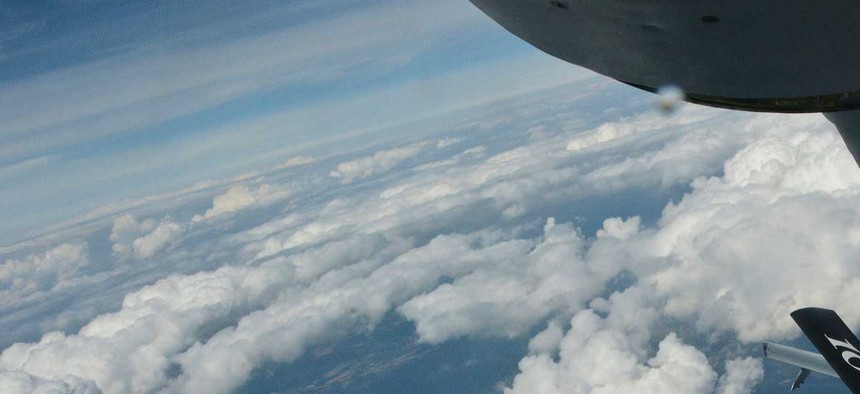
A KC-135 from RAF Mildenhall, England, refuels a German Tornado jet over Germany, on June 24, 2014. U.S. Air Force photo by Senior Airman Micaiah Anthony
What NATO Needs to Do in the Wake of the Ukraine Crisis
NATO should leverage the crisis in European security created by Moscow to accomplish these four objectives. By John R. Deni
In just under two months, NATO heads of state will gather in Wales for their next summit meeting, which comes at a critical time for European security given Russia’s annexation of Crimea. It wasn’t designed this way – indeed, when the summit was announced last fall, the assumption was that the alliance would use the meeting to focus primarily on how it would try to rebound from the exhaustion of the decade-long war in Afghanistan.
While the alliance will certainly address how it will capitalize on the International Security Assistance Force‘s successes and learn from its failures, the specter of a revanchist Russia has cast an entirely unforeseen cloud over the NATO meeting. The alliance should leverage the crisis in European security created by Moscow, and use the opportunity to accomplish four broad objectives, and thereby address some fundamental problems.
First, the alliance should announce its intent to permanently station troops in the East, most likely in Poland. Why Poland? Northeastern Europe is far more at risk for Russian misbehavior than southeast (think Romania/Bulgaria) or central Europe (Czech Republic, Slovakia). Furthermore, Poland is home to the Drawsko Pomorskie training area (DPTA), which at 340 square kilometers is far larger than training areas in any of the Baltic countries. Units exercising at DPTA can conduct live-fire and maneuver training, plus DPTA is home to an airstrip, barracks, a railhead with links to nearby Baltic Sea ports and other infrastructure. Basing in Poland – vice any of the Baltic countries – provides greater strategic depth for NATO forces in the event of a worst-case scenario. Plus, logistically speaking, it allows for easier resupply than would be the case with a base in the Baltic countries, given the rail gauge difference between the Baltic countries on the one hand, and Poland and most of the rest of Europe on the other.

In order to build interoperability as well as equitably share defense burdens and risks, the Western forces based there should be multinational, consisting of a U.S.-led brigade headquarters and subordinate combat and support battalions from the United States, the United Kingdom, Germany and other allies. Moreover, the forces ought to be permanently stationed there, not rotationally deployed on a periodic basis from elsewhere in Europe or North America. In the event of an actual crisis, alliance forces need to be in situ. They need to be NATO’s ‘facts on the ground’, not an escalatory crisis response option subject to a political decision in Brussels where a single ally could break consensus.
Second, NATO should ditch its two-percent defense spending goal. At the end of the Cold War, European NATO member states committed themselves to spending the equivalent of two percent of their gross domestic product as a means of equitably sharing of collective defense burdens. The only problem is that the two-percent goal is not reflective of equitable burden sharing, or at least not in isolation. The cases of Greece and Denmark exemplify this. The Greek government routinely spends more than the equivalent of two percent of its GDP on defense, yet it has relatively little to show in terms of deployable or sustainable capabilities. Meanwhile, the Danes, who routinely spend less than the equivalent of two percent, have a highly capable, deployable military, and had a relatively high casualty rate in Afghanistan. As GDPs across the alliance fluctuate with changes in the business cycle – with or without corresponding increases and decreases in defense spending – the two percent goal appears increasingly arbitrary and hence meaningless.
Instead, it would be far more effective for the alliance to develop and publish a ‘burden sharing score’ that is based on several factors, such as investments in defense research and development, acquisition budgets, contributions to recent and ongoing missions, and force usability levels. NATO defines this last concept – usability – in terms of deployability and sustainability, and a decade ago, the alliance established a goal for member state force usability. NATO regularly tracks these usability goals – 40 percent of each member’s overall land force strength should be deployable, and 8 percent of each member’s overall land force strength should either be engaged in or earmarked for sustained operations – but it has never chosen to make this information public.

Third, the alliance ought to move Allied Command Transformation (ACT) from Norfolk, Va., to Europe. ACT’s mission is to lead the transformation of NATO’s military structure, forces, capabilities, and doctrine – the only problem is that its primary audience for all of this is Europe, not North America. The U.S. military remains the primary engine of transformation within the alliance, and so it seems nonsensical to locate in the United States an alliance organization charged with transformation for all alliance militaries – in short, there’s little need in the United States for what ACT provides, but there’s great need for this in Europe.
All of ACT’s subordinate commands, including the Joint Warfare Centre in Norway, the Joint Force Training Centre in Poland, and the Joint Analysis & Lessons Learned Centre in Portugal, are in Europe. All NATO educational facilities as well as all but one of the various NATO centers of excellence – which all coordinate closely with ACT – are also in Europe, not North America. Moving ACT to Europe would enhance cooperation between NATO trainers and operators, reduce routine transportation costs for the alliance, and make NATO transformation more effective by centering such efforts among militaries that need it most.
Finally, NATO should either disband the NATO Response Force (NRF) or give U.S. Gen. Phil Breedlove, the alliance’s top military commander, greater peacetime operational control and authority over its use. Since the NRF’s creation a decade ago, it’s been used in support of Afghan elections (2004), the Athens Olympic games (2004), and disaster relief in Pakistan (2005). But inexplicably – and illogically – it has played no role in reinforcing the Baltic States, Poland, or Romania in response to Russia’s aggression in Ukraine. This is because activating the NRF requires a consensus decision by all alliance members, and some members today are more concerned with offending Russia than reinforcing newer allies in the East.

Maintaining the capabilities of the NRF on an annual basis through large, regular multinational exercises requires significant personnel and budgetary resources. If the NRF remains essentially unused – even in the face of a Russian invasion and dismemberment of a sovereign European country – better to reassign and reprioritize the precious, limited resources that go into developing and maintaining it. Currently, it represents a poor return on investment.
The security crisis that Europe now finds itself navigating has in many ways breathed new life into NATO. What had looked to be a self-congratulatory denouement in Wales has instead become a venue for recommitting NATO to its core purpose, while acknowledging that alliance interests may still compel it to remain ready for any array of challenges near and far. The alliance should not squander the opportunity the crisis provides to address some fundamental problems in where and how it provides security for its member states.
Dr. John R. Deni is a research professor of national security studies at the U.S. Army War College’s Strategic Studies Institute. You can follow him at @JohnRDeni.
